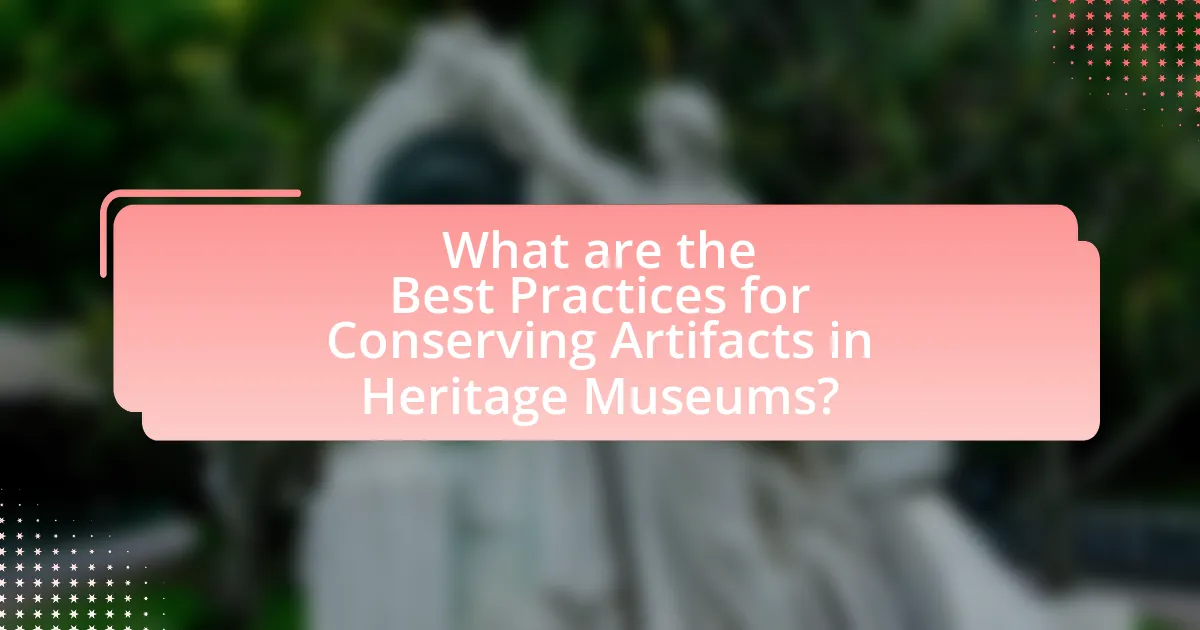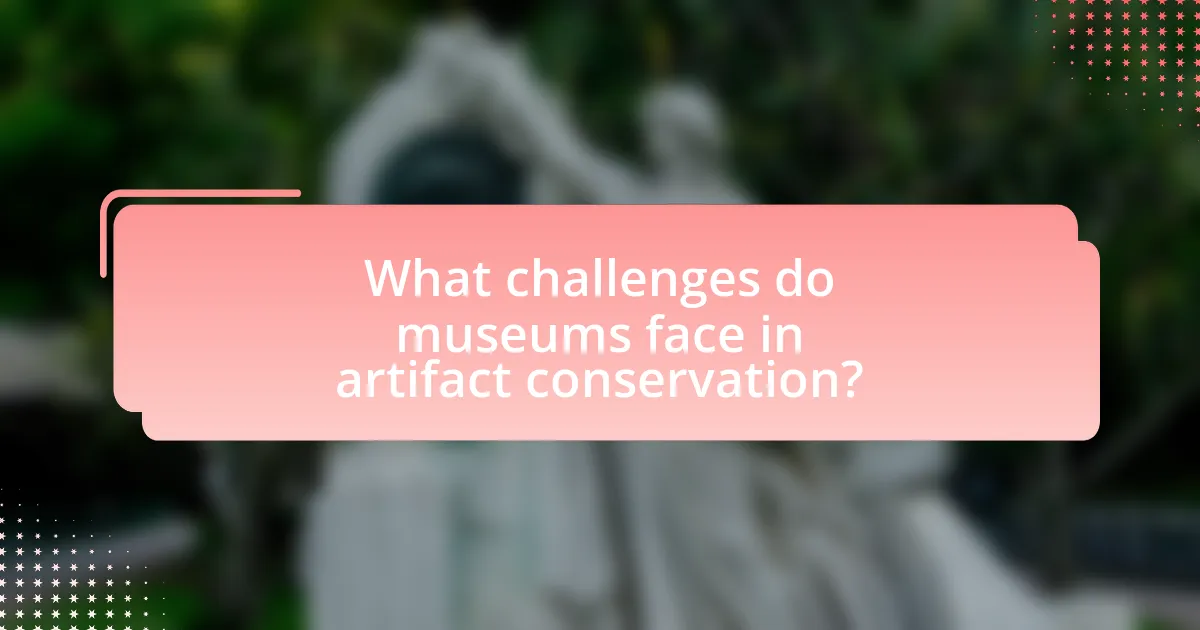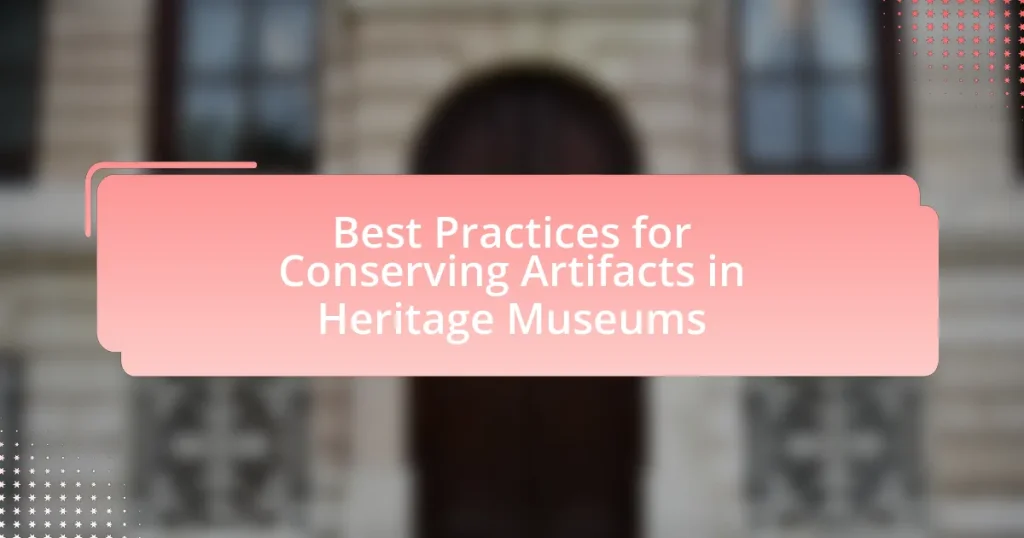The article focuses on best practices for conserving artifacts in heritage museums, emphasizing the importance of maintaining optimal environmental conditions, proper handling techniques, and appropriate storage methods. It outlines the significance of artifact conservation in preserving cultural heritage and ensuring the longevity of historical objects, while also addressing potential risks such as environmental factors, physical damage, and human error. Key principles of conservation, including preservation, stabilization, documentation, and ethical considerations, are discussed alongside the impact of environmental conditions on artifact preservation. The article further explores the role of technology, staff training, and funding challenges in enhancing conservation efforts, providing practical tips for museums to effectively protect their collections.

What are the Best Practices for Conserving Artifacts in Heritage Museums?
The best practices for conserving artifacts in heritage museums include maintaining optimal environmental conditions, implementing proper handling techniques, and utilizing appropriate storage methods. Optimal environmental conditions involve controlling temperature, humidity, and light exposure to prevent deterioration; for example, a relative humidity of 40-60% and a temperature of 18-22°C are often recommended for many materials. Proper handling techniques require trained staff to use gloves and support structures to minimize physical damage during interactions with artifacts. Appropriate storage methods involve using acid-free materials and custom supports to protect artifacts from physical stress and environmental factors. These practices are supported by guidelines from organizations such as the American Institute for Conservation, which emphasizes the importance of these measures in preserving cultural heritage.
Why is artifact conservation important in heritage museums?
Artifact conservation is crucial in heritage museums because it preserves cultural heritage and ensures the longevity of historical objects. By maintaining artifacts, museums protect the integrity of cultural narratives and provide future generations with access to their history. For instance, the American Institute for Conservation emphasizes that proper conservation techniques can significantly extend the lifespan of artifacts, allowing them to be studied and appreciated over time. This preservation not only safeguards tangible history but also supports educational initiatives and cultural identity, reinforcing the importance of conservation in heritage museums.
What are the potential risks to artifacts in museums?
Potential risks to artifacts in museums include environmental factors, physical damage, biological threats, and human error. Environmental factors such as temperature fluctuations, humidity, and light exposure can lead to deterioration of materials. For instance, high humidity can promote mold growth, while excessive light can fade colors and weaken structures. Physical damage may occur from improper handling, accidents, or inadequate display methods, which can result in breakage or wear. Biological threats, including pests like insects and rodents, can cause significant harm by consuming organic materials. Lastly, human error, such as incorrect conservation techniques or insufficient training of staff, can jeopardize the integrity of artifacts. These risks underscore the importance of implementing best practices in conservation to protect cultural heritage.
How does conservation impact the longevity of artifacts?
Conservation significantly enhances the longevity of artifacts by employing methods that stabilize and protect them from deterioration. Techniques such as controlled environmental conditions, appropriate storage materials, and regular monitoring prevent damage from factors like humidity, temperature fluctuations, and pollutants. For instance, a study published in the Journal of Cultural Heritage found that artifacts stored in stable environments showed a 50% reduction in degradation rates compared to those exposed to variable conditions. This evidence underscores the critical role of conservation practices in extending the lifespan of cultural heritage items.
What are the key principles of artifact conservation?
The key principles of artifact conservation include preservation, stabilization, documentation, and ethical considerations. Preservation focuses on maintaining the physical integrity of artifacts through controlled environmental conditions, such as temperature and humidity, to prevent deterioration. Stabilization involves repairing and reinforcing artifacts to ensure their structural soundness without altering their original state. Documentation is crucial for recording the condition, history, and treatment of artifacts, which aids in future conservation efforts and research. Ethical considerations emphasize the responsibility of conservators to respect the cultural significance and provenance of artifacts, ensuring that interventions do not compromise their historical value. These principles are widely recognized in the field of conservation, as outlined by organizations such as the American Institute for Conservation.
How do environmental conditions affect artifact preservation?
Environmental conditions significantly affect artifact preservation by influencing factors such as temperature, humidity, light exposure, and air quality. High humidity can lead to mold growth and corrosion, while low humidity can cause materials like wood and paper to dry out and crack. For instance, the American Institute for Conservation recommends maintaining relative humidity levels between 30% and 50% to prevent damage to artifacts. Additionally, temperature fluctuations can accelerate chemical reactions that degrade materials; thus, stable temperatures are crucial for long-term preservation. Light exposure, particularly ultraviolet light, can cause fading and deterioration of colors and materials, necessitating controlled lighting environments. Overall, managing these environmental factors is essential for the effective preservation of artifacts in heritage museums.
What role does documentation play in conservation practices?
Documentation plays a critical role in conservation practices by providing a systematic record of an artifact’s condition, treatment history, and provenance. This detailed information enables conservators to make informed decisions regarding the care and preservation of artifacts, ensuring that interventions are appropriate and reversible. For instance, the American Institute for Conservation emphasizes that thorough documentation is essential for tracking changes over time, which aids in assessing the effectiveness of conservation treatments and facilitates future research. Additionally, accurate documentation supports legal and ethical considerations, such as ownership and cultural significance, thereby reinforcing the integrity of conservation efforts.
What methods are commonly used for conserving artifacts?
Common methods for conserving artifacts include environmental control, preventive conservation, and restoration techniques. Environmental control involves regulating temperature, humidity, and light exposure to minimize deterioration; for example, maintaining a stable temperature of around 20°C and relative humidity of 50% is often recommended to protect sensitive materials. Preventive conservation focuses on safeguarding artifacts from potential damage through proper handling, storage, and display practices, such as using acid-free materials and UV-filtering glass. Restoration techniques may involve cleaning, repairing, or stabilizing artifacts to return them to a stable condition, which is often guided by ethical standards set by organizations like the American Institute for Conservation. These methods are widely recognized in the field of conservation and are essential for preserving cultural heritage.
What are the differences between preventive and interventive conservation?
Preventive conservation focuses on minimizing risks to artifacts through environmental controls and proper handling, while interventive conservation involves direct actions to repair or restore artifacts that have already suffered damage. Preventive measures include controlling temperature, humidity, light exposure, and pest management to prolong the life of artifacts without altering their original state. In contrast, interventive conservation may involve cleaning, repairing, or reconstructing artifacts, which can change their physical or chemical properties. The distinction lies in the proactive approach of preventive conservation versus the reactive nature of interventive conservation, as highlighted by the International Institute for Conservation, which emphasizes that preventive strategies are essential for long-term preservation.
How can technology aid in the conservation of artifacts?
Technology aids in the conservation of artifacts by providing advanced tools for preservation, documentation, and analysis. For instance, digital imaging techniques, such as 3D scanning, allow for detailed documentation of artifacts without physical contact, minimizing the risk of damage. Additionally, climate control systems equipped with sensors can monitor and adjust environmental conditions, such as temperature and humidity, to prevent deterioration. Research has shown that the use of non-invasive imaging technologies, like X-ray fluorescence, enables conservators to analyze the composition of materials without altering the artifacts, thus preserving their integrity. These technological advancements enhance the ability to conserve artifacts effectively while ensuring their historical and cultural significance is maintained.

How can museums implement effective conservation strategies?
Museums can implement effective conservation strategies by adopting a comprehensive approach that includes environmental monitoring, proper storage, and regular maintenance of artifacts. Environmental monitoring involves controlling temperature, humidity, and light exposure to prevent deterioration; for instance, maintaining relative humidity between 30-50% and temperature around 20°C is crucial for many materials. Proper storage techniques, such as using acid-free materials and appropriate shelving, help protect artifacts from physical damage. Regular maintenance, including cleaning and condition assessments, ensures that any potential issues are identified and addressed promptly. These practices are supported by guidelines from organizations like the American Institute for Conservation, which emphasizes the importance of preventive conservation to prolong the life of collections.
What steps should be taken to assess the condition of artifacts?
To assess the condition of artifacts, the following steps should be taken: conduct a visual inspection, document findings, evaluate physical and chemical stability, and implement appropriate conservation measures.
The visual inspection involves examining the artifact for any signs of damage, deterioration, or previous repairs. Documentation should include detailed notes and photographs to create a comprehensive record of the artifact’s condition. Evaluating physical and chemical stability requires testing for factors such as structural integrity, material composition, and environmental influences like humidity and temperature. Finally, based on the assessment, appropriate conservation measures should be determined, which may include cleaning, stabilization, or restoration techniques to ensure the artifact’s longevity.
How can museums prioritize artifacts for conservation efforts?
Museums can prioritize artifacts for conservation efforts by assessing their historical significance, condition, and vulnerability to damage. This systematic evaluation allows museums to allocate resources effectively, ensuring that the most important and at-risk items receive immediate attention. For instance, artifacts with unique historical value, such as those linked to significant events or figures, are often prioritized. Additionally, items that show signs of deterioration or are susceptible to environmental factors, like humidity or light exposure, are also given precedence. Research indicates that prioritizing based on these criteria can enhance the overall preservation strategy, as evidenced by the American Institute for Conservation’s guidelines, which emphasize the importance of condition assessments and risk management in conservation planning.
What tools and resources are available for conservation assessment?
Tools and resources available for conservation assessment include condition assessment checklists, digital imaging technologies, and environmental monitoring systems. Condition assessment checklists help conservators systematically evaluate the physical state of artifacts, identifying issues such as deterioration or damage. Digital imaging technologies, such as high-resolution photography and 3D scanning, allow for detailed documentation and analysis of artifacts, facilitating better conservation planning. Environmental monitoring systems track factors like temperature, humidity, and light exposure, which are critical for preserving artifacts in heritage museums. These tools collectively enhance the effectiveness of conservation assessments, ensuring artifacts are maintained in optimal conditions.
How can staff training enhance conservation efforts?
Staff training enhances conservation efforts by equipping personnel with the necessary skills and knowledge to properly care for artifacts. Trained staff can identify and mitigate risks to artifacts, implement best practices in preservation techniques, and effectively use conservation materials and tools. For instance, a study published in the Journal of Conservation and Museum Studies found that institutions with comprehensive training programs reported a 30% reduction in artifact damage over five years. This demonstrates that well-trained staff are crucial for maintaining the integrity of heritage collections.
What skills are essential for museum staff involved in conservation?
Essential skills for museum staff involved in conservation include attention to detail, knowledge of materials and techniques, analytical skills, and problem-solving abilities. Attention to detail is crucial for accurately assessing the condition of artifacts and identifying necessary conservation measures. Knowledge of materials and techniques allows staff to understand how different substances react over time and how to best preserve them. Analytical skills enable staff to evaluate the effectiveness of conservation methods, while problem-solving abilities are essential for addressing unexpected challenges that arise during the conservation process. These skills collectively ensure the effective preservation of artifacts, which is vital for maintaining cultural heritage.
How can ongoing education improve conservation practices?
Ongoing education can significantly improve conservation practices by equipping professionals with the latest knowledge and techniques in artifact preservation. Continuous learning ensures that conservators stay updated on advancements in materials science, environmental monitoring, and restoration methods, which are crucial for effective conservation. For instance, a study published in the Journal of the American Institute for Conservation highlights that conservators who engage in regular training are more adept at implementing innovative preservation strategies, leading to better outcomes for artifact longevity. This commitment to education fosters a culture of excellence and adaptability in conservation practices, ultimately enhancing the protection of cultural heritage.

What challenges do museums face in artifact conservation?
Museums face significant challenges in artifact conservation, primarily due to limited funding and resources. Financial constraints often restrict the ability to maintain optimal environmental conditions, such as temperature and humidity control, which are crucial for preserving artifacts. Additionally, the lack of trained conservators can hinder effective conservation efforts, as specialized knowledge is required to address the diverse materials and conditions of artifacts. According to a 2021 report by the American Alliance of Museums, 60% of museums cited inadequate funding as a major barrier to conservation initiatives, highlighting the widespread impact of financial limitations on preservation practices.
What are the common financial constraints affecting conservation efforts?
Common financial constraints affecting conservation efforts include limited funding, high operational costs, and competing budget priorities. Limited funding often arises from insufficient government support and dwindling private donations, which restrict the resources available for conservation projects. High operational costs, including maintenance, staffing, and materials, further strain budgets, making it challenging to allocate adequate funds for preservation activities. Competing budget priorities, such as infrastructure or education, can divert financial resources away from conservation initiatives, leading to underfunded programs. According to a 2021 report by the American Alliance of Museums, 60% of museums reported financial challenges that hindered their ability to conserve artifacts effectively.
How can museums secure funding for conservation projects?
Museums can secure funding for conservation projects through a combination of grant applications, partnerships with private donors, and fundraising events. Grant applications can be submitted to government agencies, such as the National Endowment for the Arts, which allocated over $27 million in grants for arts and cultural projects in 2021. Additionally, museums can establish partnerships with private donors and foundations that are interested in supporting cultural heritage, as many philanthropic organizations prioritize funding for conservation efforts. Fundraising events, such as auctions or community outreach programs, can also generate financial support while raising awareness about the importance of conservation. These strategies collectively enhance a museum’s ability to obtain necessary funding for preserving artifacts.
What partnerships can enhance conservation capabilities?
Collaborations between heritage museums and academic institutions can significantly enhance conservation capabilities. These partnerships facilitate access to cutting-edge research, innovative conservation techniques, and specialized training for museum staff. For instance, collaborations with universities often lead to joint research projects that explore new materials and methods for artifact preservation, as evidenced by the partnership between the Smithsonian Institution and various universities, which has resulted in advancements in conservation science. Additionally, partnerships with non-profit organizations focused on conservation can provide funding and resources, enabling museums to implement best practices in artifact care.
How do ethical considerations impact conservation practices?
Ethical considerations significantly impact conservation practices by guiding decisions on how to preserve artifacts while respecting cultural heritage and community values. For instance, conservationists must balance the need to maintain the physical integrity of artifacts with the ethical obligation to acknowledge and involve the communities from which these artifacts originate. This is evident in practices such as repatriation, where artifacts are returned to their source communities, reflecting a commitment to ethical stewardship. Additionally, ethical frameworks encourage transparency in conservation methods, ensuring that stakeholders are informed and engaged in the decision-making process. This approach not only fosters trust but also aligns conservation efforts with broader social and cultural responsibilities.
What are the debates surrounding restoration versus preservation?
The debates surrounding restoration versus preservation focus on the methods and philosophies used to maintain cultural heritage artifacts. Restoration aims to return an object to a specific historical state, often involving significant alterations or repairs, while preservation emphasizes maintaining the current condition of an artifact with minimal intervention. Critics of restoration argue that it can compromise the authenticity and integrity of the original work, as seen in cases like the restoration of the Sistine Chapel, where extensive cleaning altered the perceived colors and details. Conversely, proponents of restoration believe it can enhance the viewer’s understanding and appreciation of the artifact’s historical context. Preservation advocates stress the importance of protecting artifacts from deterioration without altering their original state, as demonstrated by the practices employed in institutions like the British Museum, which prioritize long-term stability over aesthetic restoration.
How can museums balance public access with conservation needs?
Museums can balance public access with conservation needs by implementing controlled access strategies, such as timed entry, limited exposure to light, and climate-controlled environments. These practices allow visitors to engage with artifacts while minimizing deterioration risks. For example, the British Museum uses low-light conditions in exhibition spaces to protect sensitive materials, demonstrating that careful management of environmental factors can extend the lifespan of artifacts while still providing public access. Additionally, digital technologies, such as virtual tours and high-resolution imaging, enable broader access to collections without physical handling, further supporting conservation efforts.
What practical tips can museums follow for effective artifact conservation?
Museums can follow several practical tips for effective artifact conservation, including maintaining stable environmental conditions, using appropriate storage materials, and conducting regular condition assessments. Stable environmental conditions, such as controlling temperature and humidity, are crucial as fluctuations can lead to deterioration; for example, a relative humidity of 45-55% is often recommended for many artifacts. Appropriate storage materials, like acid-free boxes and archival-quality tissue, prevent chemical reactions that can damage artifacts. Regular condition assessments allow museums to identify and address potential issues early, ensuring long-term preservation. These practices are supported by guidelines from organizations like the American Institute for Conservation, which emphasizes the importance of preventive conservation strategies.


